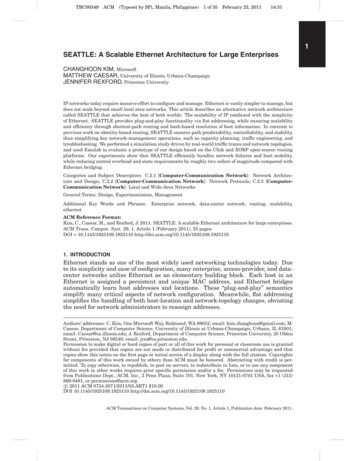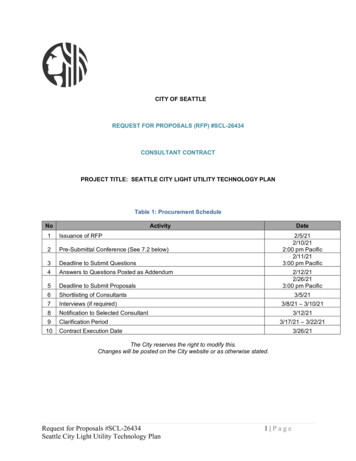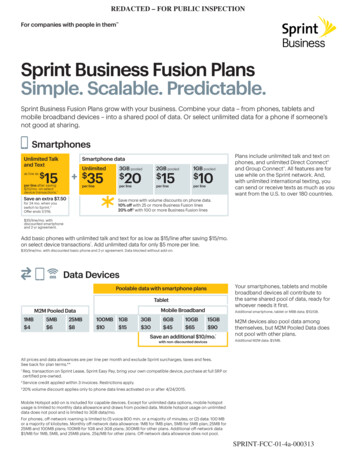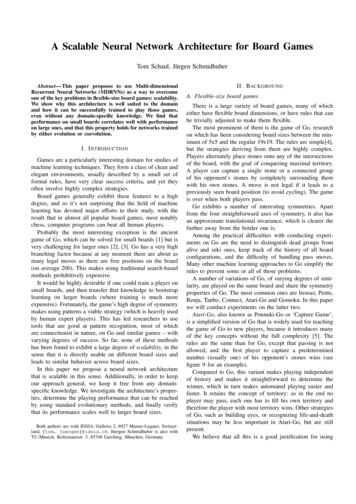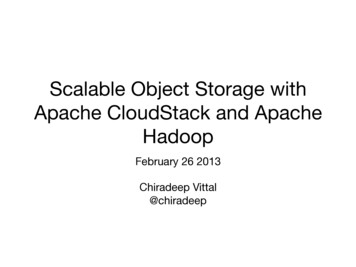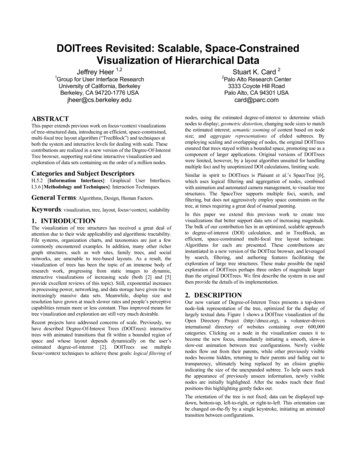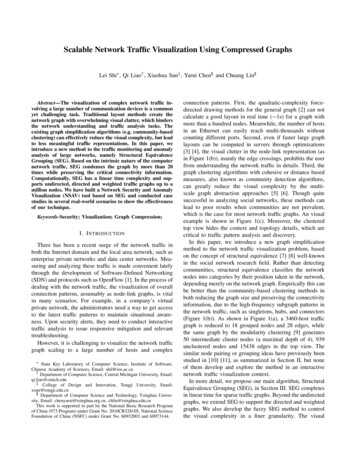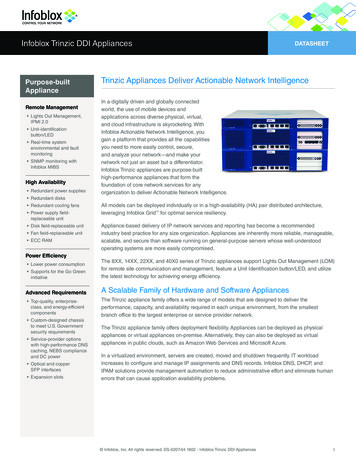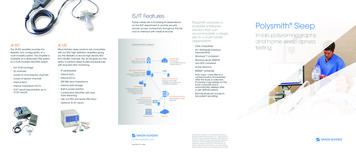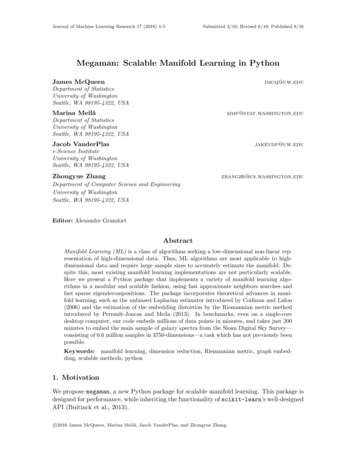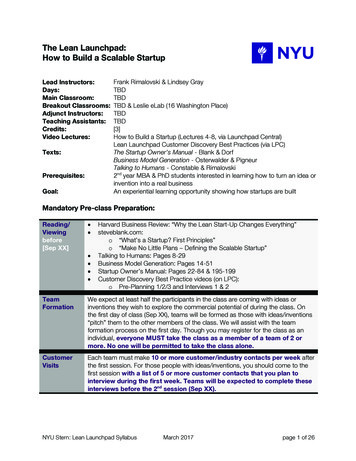
Transcription
Floodless in SEATTLE: A Scalable Ethernet Architecturefor Large EnterprisesChanghoon KimMatthew CaesarJennifer RexfordPrinceton University Princeton University Princeton UniversityAbstractIP networks today require massive effort to configure andmanage. Ethernet is vastly simpler to manage, but does notscale beyond small local area networks. This paper describesan alternative network architecture called SEATTLE thatachieves the best of both worlds: The scalability of IP combined with the simplicity of Ethernet. SEATTLE providesplug-and-play functionality via flat addressing, while ensuring scalability and efficiency through shortest-path routingand hash-based resolution of host information. In contrast toprevious work on identity-based routing, SEATTLE ensurespath predictability and stability, and simplifies network management. We performed a simulation study driven by realworld traffic traces and network topologies, and used Emulab to evaluate a prototype of our design based on the Clickand XORP open-source routing platforms. Our experimentsshow that SEATTLE efficiently handles network failures andhost mobility, while reducing control overhead and state requirements by roughly two orders of magnitude comparedwith Ethernet bridging.1.IntroductionEthernet stands as one of the most widely used networkingtechnologies today. Due to its simplicity and ease of configuration, many enterprise and access provider networks utilizeEthernet as an elementary building block. Each host in anEthernet is assigned a persistent MAC address, and Ethernet bridges automatically learn host addresses and locations.These “plug-and-play” semantics simplify many aspects ofnetwork configuration. Flat addressing simplifies the handling of topology changes and host mobility, without requiring administrators to perform address reassignment.However, Ethernet is facing revolutionary challenges. Today’s layer-2 networks are being built on an unprecedentedscale and with highly demanding requirements in terms ofefficiency and availability. Large data centers are being built,comprising hundreds of thousands of computers within asingle facility [1], and maintained by hundreds of networkoperators. To reduce energy costs, these data centers employ virtual machine migration and adapt to varying workloads, placing additional requirements on agility (e.g., hostmobility, fast topology changes). Additionally, large metroEthernet deployments contain over a million hosts and tensof thousands of bridges [2]. Ethernet is also being increasingly deployed in highly dynamic networks, for example asbackhaul for wireless campus networks, and in transport networks for developing regions [3].While an Ethernet-based solution becomes all the moreimportant in these environments because it ensures servicecontinuity and simplifies configuration, conventional Ethernet has some critical limitations. First, Ethernet bridgingrelies on network-wide flooding to locate end hosts. Thisresults in large state requirements and control message overhead that grows with the size of the network. Second, Ethernet forces paths to comprise a spanning tree. Spanning treesperform well for small networks which often do not havemany redundant paths anyway, but introduce substantial inefficiencies on larger networks that have more demandingrequirements for low latency, high availability, and traffic engineering. Finally, critical bootstrapping protocols used frequently by end hosts, such as Address Resolution Protocol(ARP) and Dynamic Host Configuration Protocol (DHCP),rely on broadcasting. This not only consumes excessive resources, but also introduces security vulnerabilities and privacy concerns.Network administrators sidestep Ethernet’s inefficienciestoday by interconnecting small Ethernet LANs using routersrunning the Internet Protocol (IP). IP routing ensures efficient and flexible use of networking resources via shortestpath routing. It also has control overhead and forwardingtable sizes that are proportional to the number of subnets(i.e., prefixes), rather than the number of hosts. However, introducing IP routing breaks many of the desirable propertiesof Ethernet. For example, network administrators must nowsubdivide their address space to assign IP prefixes across thetopology, and update these configurations when the networkdesign changes. Subnetting leads to wasted address space,and laborious configuration tasks. Although DHCP automates host address configuration, maintaining consistencybetween DHCP servers and routers still remains challenging. Moreover, since IP addresses are not persistent identifiers, ensuring service continuity across location changes(e.g., due to virtual machine migration or physical mobility) becomes more challenging. Additionally, access-controlpolicies must be specified based on the host’s current position, and updated when the host moves.Alternatively, operators may use Virtual LANs (VLANs)to build IP subnets independently of host location. Whilethe overhead of address configuration and IP routing may bereduced by provisioning VLANs over a large number of, ifnot all, bridges, doing so reduces benefits of broadcast scoping, and worsens data-plane efficiency due to larger spanningtrees. Efficiently assigning VLANs over bridges and linksmust also consider hosts’ communication and mobility pat-
multicasting. To offer broadcast scoping and access control,SEATTLE also provides a more scalable and flexible way tocreate VLANs that reduces manual configuration overhead.terns, and hence is hard to automate. Moreover, since hostsin different VLANs still require IP to communicate with oneanother, this architecture still inherits many of the challengesof IP mentioned above.In this paper, we address the following question: Isit possible to build a protocol that maintains the sameconfiguration-free properties as Ethernet bridging, yetscales to large networks? To answer this question, wepresent a Scalable Ethernet Architecture for Large Enterprises (SEATTLE). Specifically, SEATTLE offers the following novel features:1.1 Related workOur quest is to design, implement, and evaluate a practical replacement for Ethernet that scales to large and dynamic networks. Although there are many approaches toenhance Ethernet bridging, none of these are suitable forour purposes. SmartBridges [6] and RBridges [7, 8] leverage a link-state protocol to disseminate information aboutboth bridge connectivity and host state. This eliminates theneed to maintain a spanning tree and improves forwardingpaths. CMU-Ethernet [9] also leverages link-state, but eliminates per-host broadcasting by propagating host informationin link-state updates. Viking [10] uses multiple spanningtrees for faster fault recovery, which can be dynamically adjusted to conform to changing load. Though SEATTLE wasinspired by the problems addressed in these works, it takesa radically different approach that eliminates network-widedissemination of per-host information. This results in substantially improved control-plane scalability and data-planeefficiency. While there have been works on using hashing to support flat addressing conducted in parallel withour work [11, 12, 13], these works do not promptly handlehost dynamics, require some packets to be detoured awayfrom the shortest path or be forwarded along a spanningtree, and do not support hierarchical configurations to ensure fault/path isolation and the delegation of administrativecontrol necessary for large networks.The design we propose is also substantially different fromrecent work on identity-based routing (ROFL [14], UIP [15],and VRR [16]). Our solution is suitable for building apractical and easy-to-manage network for several reasons.First, these previous approaches determine paths based ona hash of the destination’s identifier (or the identifier itself), incurring a stretch penalty (which is unbounded inthe worst case). In contrast, SEATTLE does not performidentity-based routing. Instead, SEATTLE uses resolutionto map a MAC address to a host’s location, and then usesthe location to deliver packets along the shortest path to thehost. This reduces latency and makes it easier to controland predict network behavior. Predictability and controllability are extremely important in real networks, because theymake essential management tasks (e.g., capacity planning,troubleshooting, traffic engineering) possible. Second, thepath between two hosts in a SEATTLE network does notchange as other hosts join and leave the network. This substantially reduces packet reordering and improves constancyof path performance. Finally, SEATTLE employs trafficdriven caching of host-information, as opposed to the trafficagnostic caching (e.g., finger caches in ROFL) used in previous works. By only caching information that is needed toforward packets, SEATTLE significantly reduces the amountof state required to deliver packets. However, our design alsoconsists of several generic components, such as the multilevel one-hop DHT and service discovery mechanisms, thatA one-hop, network-layer DHT: SEATTLE forwards packets based on end-host MAC addresses. However, SEATTLEdoes not require each switch to maintain state for every host,nor does it require network-wide floods to disseminate hostlocations. Instead, SEATTLE uses the global switch-levelview provided by a link-state routing protocol to form a onehop DHT [4], which stores the location of each host. Weuse this network-layer DHT to build a flexible directory service which also performs address resolution (e.g., storingthe MAC address associated with an IP address), and moreflexible service discovery (e.g., storing the least loaded DNSserver or printer within the domain). In addition, to provide stronger fault isolation and to support delegation of administrative control, we present the design of a hierarchical,multi-level one-hop DHT.Traffic-driven location resolution and caching: To forwardpackets along shortest paths and to avoid excessive load onthe directory service, switches cache responses to queries.In enterprise networks, hosts typically communicate with asmall number of other hosts [5], making caching highly effective. Furthermore, SEATTLE also provides a way to piggyback location information on ARP replies, which eliminates the need for location resolution when forwarding datapackets. This allows data packets to directly traverse theshortest path, making the network’s forwarding behaviorpredictable and stable.A scalable, prompt cache-update protocol: Unlike Ethernetwhich relies on timeouts or broadcasts to keep forwardingtables up-to-date, SEATTLE proposes an explicit and reliable cache update protocol based on unicast. This ensuresthat all packets are delivered based on up-to-date state whilekeeping control overhead low. In contrast to conventionalDHTs, this update process is directly triggered by networklayer changes, providing fast reaction times. For example,by observing link-state advertisements, switches determinewhen a host’s location is no longer reachable, and evict thoseinvalid entries. Through these approaches, SEATTLE seamlessly supports host mobility and other dynamics.Despite these features, our design remains backwardscompatible with existing applications and protocols runningat end hosts. For example, SEATTLE allows hosts to generate broadcast ARP and DHCP messages, and internallyconverts them into unicast-based queries to a directory service. SEATTLE switches can also handle general (i.e., nonARP and non-DHCP) broadcast traffic through loop-free2
could be reused and adapted to the work in [14, 15, 16].Roadmap: We summarize how conventional enterprise networks are built and motivate our work in Section 2. Then wedescribe our main contributions in Sections 3 and 4 wherewe introduce a very simple yet highly scalable mechanismthat enables shortest-path forwarding while maintaining thesame semantics as Ethernet. In Section 5, we enhance existing Ethernet mechanisms to make our design backwardscompatible with conventional Ethernet. We then evaluateour protocol using simulations in Section 6 and an implementation in Section 7. Our results show that SEATTLEscales to networks containing two orders of magnitude morehosts than a traditional Ethernet network. As comparedwith ROFL, SEATTLE reduces state requirements requiredto achieve reasonably low stretch by a factor of ten, and improves path stability by more than three orders of magnitudeunder typical workloads. SEATTLE also handles networktopology changes and host mobility without significantly increasing control overhead.2.Globally disseminating every host’s location: Flooding andsource-learning introduce two problems in a large broadcastdomain. First, the forwarding table at a bridge can growvery large because flat addressing increases the table sizeproportionally to the total number of hosts in the network.Second, the control overhead required to disseminate eachhost’s information via flooding can be very large, wastinglink bandwidth and processing resources. Since hosts (ortheir network interfaces) power up/down (manually, or dynamically to reduce power consumption), and change location relatively frequently, flooding is an expensive way tokeep per-host information up-to-date. Moreover, malicioushosts can intentionally trigger repeated network-wide floodsthrough, for example, MAC address scanning attacks [18].Inflexible route selection: Forcing all traffic to traverse asingle spanning tree makes forwarding more failure-proneand leads to suboptimal paths and uneven link loads. Loadis especially high on links near the root bridge. Thus, choosing the right root bridge is extremely important, imposing anadditional administrative burden. Moreover, using a singletree for all communicating pairs, rather than shortest paths,significantly reduces the aggregate throughput of a network.Dependence on broadcasting for basic operations: DHCPand ARP are used to assign IP addresses and manage mappings between MAC and IP addresses, respectively. A hostbroadcasts a DHCP-discovery message whenever it believesits network attachment point has changed. Broadcast ARPrequests are generated more frequently, whenever a hostneeds to know the MAC address associated with the IP address of another host in the same broadcast domain. Relyingon broadcast for these operations degrades network performance. Moreover, every broadcast message must be processed by every end host; since handling of broadcast framesis often application or OS-specific, these frames are not handled by the network interface card, and instead must interrupt the CPU [19]. For portable devices on low-bandwidthwireless links, receiving ARP packets can consume a significant fraction of the available bandwidth, processing, andpower resources. Moreover, the use of broadcasting for ARPand DHCP opens vulnerabilities for malicious hosts as theycan easily launch network-wide ARP or DHCP floods [9].Today’s Enterprise and Access NetworksTo provide background for the remainder of the paper, andto motivate SEATTLE, this section explains why Ethernetbridging is limited to small LANs. Then we describe hybrid IP/Ethernet networks and VLANs, two widely-used approaches which improve scalability over conventional Ethernet, but introduce management complexity, eliminatingmany of the “plug-and-play” advantages of Ethernet.2.1 Ethernet bridgingAn Ethernet network is composed of segments, each comprising a single physical layer 1 . Ethernet bridges are usedto interconnect multiple segments into a multi-hop network,namely a LAN, forming a single broadcast domain. Eachhost is assigned a unique 48-bit MAC (Media Access Control) address. A bridge learns how to reach hosts by inspecting the incoming frames, and associating the source MACaddress with the incoming port. A bridge stores this information in a forwarding table that it uses to forward framestoward their destinations. If the destination MAC addressis not present in the forwarding table, the bridge sends theframe on all outgoing ports, initiating a domain-wide flood.Bridges also flood frames that are destined to a broadcastMAC address. Since Ethernet frames do not carry a TTL(Time-To-Live) value, the existence of multiple paths in thetopology can lead to broadcast storms, where frames are repeatedly replicated and forwarded along a loop. To avoidthis, bridges in a broadcast domain coordinate to compute aspanning tree that is used to forward frames [17]. Administrators first select and configure a single root bridge; then,the bridges collectively compute a spanning tree based ondistances to the root. Links not present in the tree are notused to carry traffic, causing longer paths and inefficient useof resources. Unfortunately, Ethernet-bridged networks cannot grow to a large scale due to following reasons.2.2 Hybrid IP/Ethernet architectureOne way of dealing with Ethernet’s limited scalability isto build enterprise and access provider networks out of multiple LANs interconnected by IP routing. In these hybridnetworks, each LAN contains at most a few hundred hoststhat collectively form an IP subnet. An IP subnet is givenan IP prefix representing the subnet. Each host in the subnet is then assigned an IP address from the subnet’s prefix.Assigning IP prefixes to subnets, and associating subnetswith router interfaces is typically a manual process, as theassignment must follow the addressing hierarchy, yet mustreduce wasted namespace, and must consider future use ofaddresses to minimize later reassignment. Unlike a MACaddress, which functions as a host identifier, an IP addressdenotes the host’s current location in the network. Since1 Inmodern switched Ethernet networks, a segment is just a point-to-pointlink connecting an end host and a bridge, or a pair of bridges.3
2.3 Virtual LANsIP routing protocols use a different addressing and pathselection mechanism from Ethernet, it is impossible to sharerouting information across the two protocols. This forcesthe two protocols to be deployed independently, and be connected only at certain fixed nodes called default gateways.The biggest problem of the hybrid architecture is its massive configuration overhead. Configuring hybrid networkstoday represents an enormous challenge. Some estimatesput 70% of an enterprise network’s operating cost as maintenance and configuration, as opposed to equipment costs orpower usage [20]. In addition, involving human administrators in the loop increases reaction time to faults and increasespotential for misconfiguration.Configuration overhead due to hierarchical addressing:An IP router cannot function correctly until administratorsspecify subnets on router interfaces, and direct routing protocols to advertise the subnets. Similarly, an end host cannotaccess the network until it is configured with an IP addresscorresponding to the subnet where the host is currently located. DHCP automates end-host configuration, but introduces substantial configuration overhead for managing theDHCP servers. In particular, maintaining consistency between subnet router configuration and DHCP address allocation configuration, or coordinating policies across distributed DHCP servers, are not simple matters. Finally, network administrators must continually revise this configuration to handle network changes.Complexity in implementing networking policies: Administrators today use a collection of access controls, QoS(Quality of Service) controls [21], and other policies to control the way packets flow through their networks. These policies are typically defined based on IP prefixes. However,since prefixes are assigned based on the topology, changesto the network design require these policies to be rewritten.More significantly, rewriting networking policies must happen immediately after network design changes to preventreachability problems and to avoid vulnerabilities. Ideally,administrators should only need to update policy configurations when the p
Additionally, large metro Ethernet deployments contain over a million hosts and tens of thousands of bridges [2]. Ethernet is also being increas-ingly deployed in highly dynamic networks, for example as backhaulfor wireless campus networks, and in transportnet-works for developing regions [3]. While an
